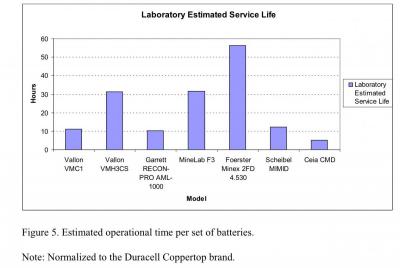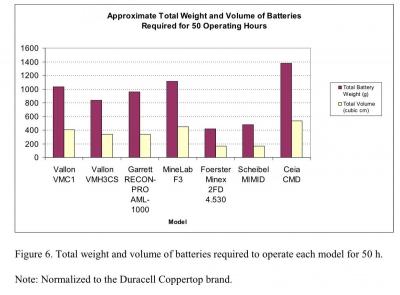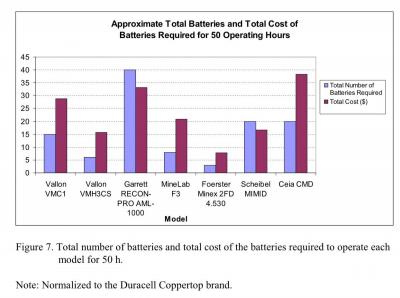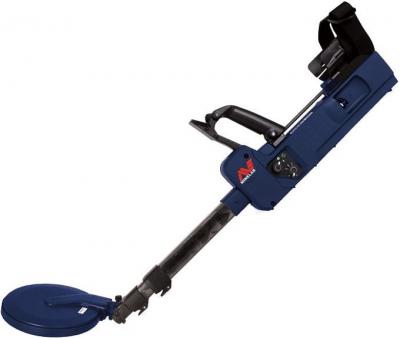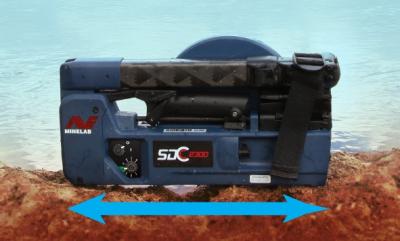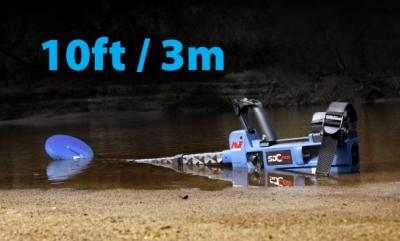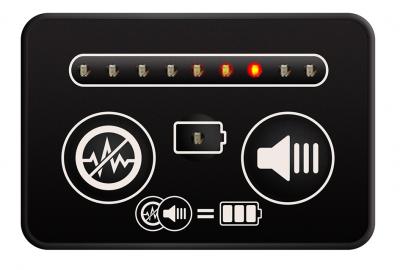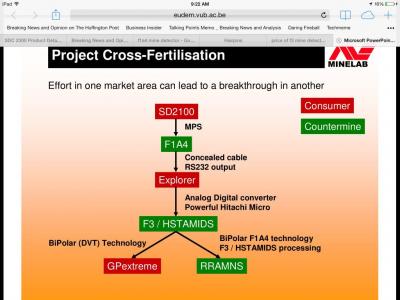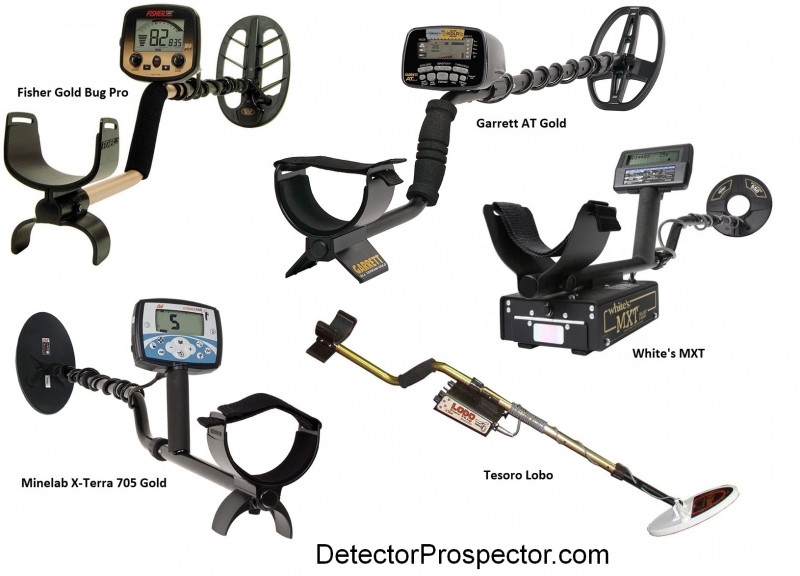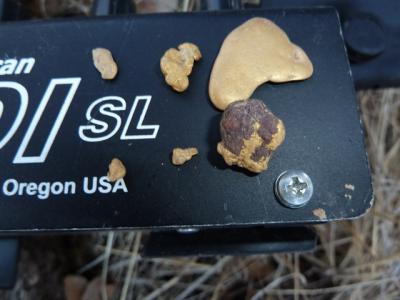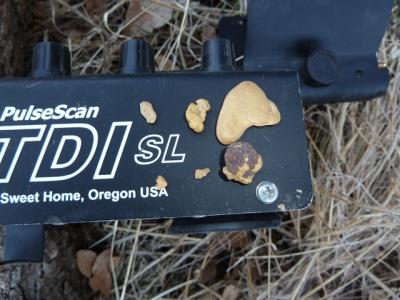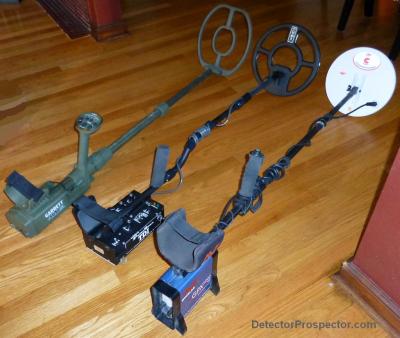Search the Community
Showing results for 'Pulse dive'.
-

An ATX Proposal
Steve Herschbach replied to Rick K - First Member's topic in Garrett Metal Detectors
Hi John, I hope your heart troubles are treatable and under control. Health is everything. Garrett at http://www.garrett.com/cmerwsite/recon_pro_aml_1000_tech_specs.aspx quotes the Recon at 14-16 hours but of course that is manufacturer best case stuff. The military did a study at http://www.arl.army.mil/arlreports/2010/ARL-TR-5282.pdf comparing battery life on several demining detectors. The Garrett Recon-Pro AML-1000 comes in at about 10 hours in the study which is about what I have experienced with rechargeables, alkalines should get closer to Garrett's figure. Interesting to note in the study of all the detectors the AML-1000 fared the worst as taking the most batteries at the highest cost to operate for 50 hours. Long story short the AML-1000 and ATX appear to have about the same battery life. However, battery life is a poor indication if any indication at all of detector capability. I have never used the AML-1000 but have no reason to believe that in non-motion mode the detectors are roughly the same for depth of detection. My ATX has very little useable extra depth in non-motion mode, if any. All I can tell you from personal experience is this. The Garrett ATX is a very good ground balancing pulse induction metal detector. It has become one of my key units and I very much look forward to getting out and using it. The weight for dry land detecting will be an issue for most people and I highly recommend using a harness. But weight aside it is an excellent detector circuit that runs more like a VLF than a PI. It has excellent EMI resistance and a steady, well modulated audio response. The tones and modulated audio allow for a great degree of audio discrimination capability for those inclined to hunting by ear. I am not trying to sell you on the ATX but it is a detector worth consideration for those who truly understand the benefits and downsides to pulse induction detecting. It is because it is such a good detector that I keep harping on Garrett producing a lighter weight version. If it was mediocre I would not care. -
Recently got this tdi, have studied over and over everything I could get my hands on to gain a little knowlege of this PI. I have only hunted 3 times so far(6hrs.maybe) what a cool, machine never been around them but wanted to try one. First time out was overwelming, almost, wrote everythig down I did. 2nd. Time out was getting to understand it now, alot of experimenting found 8 coins and a lot of you name it.running in all full gain pulse 10 in this ground gb about 8. Wasnt sure if I had brought a long enough shovel for it's capability, wished I had a tape I dug 2 beer cans burried easily24 inches first 6 or 8 inches was dirt and rock then pure wet sand.It would have hit these even deeper, you guys that run these already now that. Trying to teach myself the different variations of targets, gonna take time for sure. Have a few questions I hope to get some answers to. By the way I ran 2 coils experimenting.(7.5-12") I did some air tests with some nuggets I have found with gb2, apparently the current doesnt hold well on porres nuggets under 6 grams, maybe my settings, but I tried with it set full power and didnt get much response on the porres, I think I read it cant hold current very well on targets like these, is that true and to what extent? Havent got to do any under ground testing yet ground still muddy and frozen. Thanks for any input here rick I want to take this to the desert shortly, now wondering if it will still go very deep on these big nuggets that could be over half ounce we now there are more here, just want some input on this dellima. just hoped it would go deeper than gb2 that have found several BIGnuggets here.
-
Not to raise the dead but maybe they bought some of the NEVER_QUITE_READY pulse-devil design concepts...which at the time sounded like it would be the final answer to prospectors prayers... Sooner or later someone will make these technologies work in the real world...I hope I can still swing a detector when that happens. fred
-
From http://www.minelab.com/usa/consumer/knowledge-base/news?article=215928 1/31/14 Minelab SDC 2300 - Click on image for larger picture Minelab is pleased to provide further information about our exciting new SDC 2300 GOLD detector scheduled for release in mid-2014. Compact Size - Folds to small portable size, 8 ½ ” (216mm) by 16” (406mm). Fits into carry-on luggage and most backpacks. Rugged & Assembly Free - Military grade construction, one piece detector designed to perform in the toughest conditions. Waterproof Capability - Fully submersible to 10’ (3m) for detecting riverbeds and shorelines allowing you to transition with ease from land to water. Now you can use your Minelab GOLD detector in all wet weather conditions allowing you to stay on the goldfields for longer, even in the rainy season. Easy Patch Hunting - Search quickly and efficiently in hard to reach and remote places to find those elusive gold bearing clustered deposits. Easy-to-use Controls LED Indicators - Shows target signal strength, threshold level and battery status. Audio Control - Adjusts threshold level and low/high audio tone to suit user preference. Noise Cancel - Easy button press to automatically reduce external interference. Sensitivity - Eight position adjustments for optimum target identification in varying ground conditions. MPF Technology - MPF (Multi Period Fast) technology incorporates extremely fast Pulse Induction switching between Transmit (Tx) and Receive (Rx) detector signals. Therefore minimal residual transmit signal is present during the receive cycle, enabling clear sharp detection of very small gold. Standard Accessories (included with detector) - Headphones (non waterproof) Optional Accessories (not included with detector) - Headphones (Waterproof), Carry Bag Detector Technical Specifications Coil - 8" Round Monoloop Audio Output - Built-in speaker, Koss 100 Ohm headphones (standard accessory - supplied), Koss waterproof headphones (optional accessory - not supplied) Display - 9 LEDs indicate detection, battery status and Threshold level, 1 Low battery warning LED Length - Extended: 1500mm (59.1"), Collapsed: 400mm (15.7") Weight (Excluding Batteries and Headphones) - 2.4kg (5.3lbs) Operating Temperature Range - 0°C to 50°C (32°F to 122°F) Storage Temperature Range –33°C to 70°C (–27°F to 1°F) Batteries - C Cell 4 x 1.5V Alkaline (supplied), 1.2V NiMH (optional), 1.2V Ni-Cad (optional) Sensitivity - 8 step position adjustment Noise Cancel - Automatic scanning Ground Balance - Automatic Ground Tracking (AGT), Fast Ground Balance Threshold - 9 audio levels Audio Pitch (Tone) - Low: 550Hz ±15, High: 720Hz ±15 Transmission - Pulse Induction Technology - Multi Period Fast (MPF) Optional Accessories - Waterproof Headphones, Carry Bag
-
Garrett ATX Review - Beach Detecting In Hawaii
Keith Southern replied to Steve Herschbach's topic in Garrett Metal Detectors
Great report on the ATX Steve....very well written to I might add... and Yes the ATX is very very very EMI resistant is it not...unreal how calm they have it even in urban areas full of electrical smog... Congrat's on the find's... yes those ring's could of made you write down a over biased raving review...some time elapsed does help take it all in for review purposes.. and yet I see the ATX as one well engineered pulse machine... again a 21st century pulse...and I see no need to revert back to the Infinium and as of now even the TDI... thanks for the excellent read as alway's.. you deserve the goodies!! Keith- 22 replies
-
- jewelry detecting
- garrett atx
-
(and 1 more)
Tagged with:
-

Minelab SDC 2300 Product Details
Steve Herschbach replied to Steve Herschbach's topic in Minelab Metal Detectors
The basic pulse induction detector sends a pulse of current through a coil in the search head. At the end of the pulse the current is shut off. Once a current is running it does not like to stop suddenly and there is a "boomerang effect" that briefly induces a very large voltage spike across the coil. Once this transient spike dissipates, the detector can go into receive mode. The intentional portion is referred to as the "transmit pulse" and the follow up spike the "flyback pulse". There are different ways of looking at the situation but in most cases the flyback pulse is viewed as a problem to be dealt with. The sooner the detector can receive or "sample" the better it is at detecting quickly disappearing signals from small gold. The whole MPF thing is just another acronym for our collection referring to Minelabs method of dealing with the flyback pulse and achieving greater sensitivity to small gold. Whether it is SD based or GP based is all rather beside the point. All that matters is how it works in the field. I expected you to come out swinging harder on the price Rick. On other forums you have stated the SDC 2300 is "DOA" at certain price levels. How do you account for the GPX being the most expensive consumer detector sold and yet sold in huge numbers world-wide? I am not arguing with you though and indeed please voice your opinion on the subject. Until the unit is actually on the market Minelab has time to gauge responses and set the price wherever they want. You have a very valid point on the SDC versus ATX for the price and what they offer. I think you are missing something though. The SDC is not bring priced against the Garrett ATX. It is being priced against a GPX 5000 and will be marketed world wide to people who will not consider anything that does not say Minelab on it. The SDC is compact, waterproof, simple to operate, and most importantly, runs on regular batteries. At two thirds the price of a GPX if they can get just a few Africans to use it and find gold with it then they may have the next hot machine. The way things work over there defy normal marketing beliefs and ideas. -

Minelab SDC 2300 Product Details
Rick K - First Member replied to Steve Herschbach's topic in Minelab Metal Detectors
The SDC is very likely based on the F3 Compact mine detector in much the same fashion that the Garrett ATX is based on the Garrett Recon mine detector. Folks that have owned the Recon and now have an ATX make it clear that there have been significant improvements in the ATX to make it more suitable for detecting gold. It's reasonable to expect that Minelab have done something similar with the transition from the F3 Compact to the SDC. if you look at Minelabs information online for the F3 compact - and the F3 which it was derived from - you will see that they talk about multiperiod sensing or MPS. This is the technology that was introduced with the original SD series detectors right through the ST 2200. The STC announces Multi Period Fast sensing or MPF. This probably means that the pulse delay is shorter than in the F3. Here's a nice ML power point slide showing the evolution. Per this, the SDC is pretty clearly refined SD technology, not GP technology. -

Minelab SDC 2300 Product Details
Rick K - First Member replied to Steve Herschbach's topic in Minelab Metal Detectors
MPF apparently means shorter pulse delay. This plus perhaps other timing variations are what they would do to improve the sensitivity to small gold. This will probably limit coil choice and may make it difficult to adapt existing SD/GPX coils even if a way to hook them up is found. It's an attractive package and has been described as very rugged. If the performance rivals or exceeds the ATX it should sell well at the right price. But then there's the question of price. A dealer told me recently that ML had indicated $3800 as the price that they were considering. An Australian site shows them at $3999 Australian $ - that's $3500 US. If that's the price here it is a heck of a premium over the ATX. http://www.detectaden.com.au/products/Minelab-SDC-2300-Metal-Detector.html -
Despite all the noise about pulse induction (PI) metal detectors these days I firmly believe that in the United States most beginning and many professional nugget hunters are often better served with a good mid-frequency VLF. For beginners I think it is more important to master the real skills involved in prospecting before investing a ton of money in a metal detector. If you can't find gold with a $700 detector there is little point in investing thousands of dollars in a detector that still probably will not find the person any gold. Perhaps a PI is required in most of Australia but I have seen very few places in the United States where a good VLF will not work very well or at least well enough. Certainly in Alaska that is the case, where low mineral ground and smallish gold is the norm. Even locations where large gold lurks are so loaded with iron junk a PI detector has a hard go of it. It is nearly impossible to convince die-hard PI users to accept this until they experience it for themselves. One of the best detectorists I know has found hundreds of ounces of gold including two nuggets each weighing over a pound, all with a White's MXT. He also has a Minelab GPX 5000 and is very good with it. This last summer we hunted a lot together in junk infested tailing piles. I tended to use my GPX 5000 and he tended to use his MXT. We ran neck and neck for finds, and he detected less and dug way less junk than I. When all the shallow stuff is gone a PI shows its value with extra depth. But in target rich environments, especially ones filled with junk, a good VLF is a worthy choice. Let's set the VLF versus PI thing aside though and accept for the purposes of this article that VLF detectors are still a good choice for many people in the United States. I know for a fact I could own nothing but a VLF and do very well indeed. So what VLF to own? Two detectors stand out in their high operating frequency as dedicated nugget detectors, the Fisher Gold Bug 2 and White's GMT. I could make a great argument for why either of these detectors will eke out gold where other detectors fail and do it consistently enough that a skilled operator would be wise to own either one. However, I think overall a better case can be made that if a person had to own just one VLF detector, a mid-frequency model would be a better choice. There is much more versatility offered plus a better balance of performance on all ground types and all gold sizes than the hot high frequency models. The contenders from the "Big Five" brands? The Fisher Gold Bug Pro (also sold as Teknetics G2), Garrett AT Gold, Minelab X-Terra 705 Gold, Tesoro Lobo SuperTRAQ, and White's MXT. All available for around $700 more or less. This is the choice I personally faced, and the decision took several years of use to settle. What follows is purely personal but I will explain why I ended up where I did. Fisher Gold Bug Pro, Garrett AT Gold, Minelab X-Terra 705 Gold, Tesoro Lobo, White's MXT First up, the White's MXT. Simply a superb detector, and one that has found me pounds of gold. Yet I am just going to go ahead and blow White's off at this point! Why? The weight. I am sorry White's, but at 4.3 pounds the MXT is the heaviest detector in this slug-fest. I love what the detector does, but I am no longer willing to forgive detectors with poor ergonomic factors, weight being the most obvious. In the 21st century, the day and age of the iPhone, poor ergonomics is not acceptable. The MXT needs to lose a pound, plain and simple. So I sold my MXT after one particularly arm wearing day. Now the Tesoro Lobo SuperTRAQ is a great beginners detector in that it is very easy to operate, but it also gets put aside. The detector is locked in ground tracking at all times while in all metal nugget mode. This is great for beginners but I personally find it unacceptable. I almost never use ground tracking systems as they mess with the signals from weak targets. If there was a locked or fixed mode it would be fine. Worse yet, the alternative discriminate mode has a factory pre-set ground balance. Sorry, fail. Just my opinion, but the Lobo is way overdue for an update after 16 years on the market. Garrett is to be commended for finally producing a waterproof detector that does not penalize the owner by weighing a ton and removing all the features. The AT Gold is a miracle in being waterproof and yet fully featured, with even the speaker being waterproof. And only three pounds with batteries! This detector is so wonderful I really do feel bad about taking a pass on it here also. Why? Sadly, the waterproof design also means special o-ring connectors for the coils and headphones. If you do not need the detector to be waterproof they are delicate connectors that collect dirt and require quite a bit of care to not mess up. The coil connection in particular is in a maddening location making it almost impossible to connect coils with bare fingers alone. A special adapter must be purchased if you want to have a choice in headphones. If you want waterproof the AT Gold is an obvious choice but I do not need waterproof for most of my nugget detecting. So down to two models, the Fisher Gold Bug Pro and Minelab X-Terra 705 Gold. Both under the magic 3 pound mark! Both with extremely powerful all metal modes. So powerful that in all metal mode these detectors give the PI units a run for depth in most ground on most gold in the US. This was tough for me as the X-Terra has a far richer feature set than the Gold Bug Pro and for many all around users would be the better choice. But I looked at both from strictly a nugget hunting perspective where those extra features are extraneous to the task at hand. It came down to this. In all metal mode the Gold Bug Pro is simultaneously and separately running in discriminate mode. The audio response is pure all metal, but you also get the probable target id, when possible, displayed on the screen. Very deep targets will have no target id, which is why we are using all metal prospect mode in the first place. The X-Terra 705 you can run in Prospect Mode or Discriminate Mode, but not both at once. This one thing leads to more efficient detecting with all the information you need on screen at once. The Gold Bug Pro gives you the target id, ground phase, and magnetic susceptibility reading all on screen at once while in all metal mode. ads by Amazon... That is how I settled on the Fisher Gold Bug Pro as my all around do everything nugget hunting model. It is not a coincidence it is also the lightest of the bunch at only 2.5 lbs with battery and 5” round DD coil and 2.7 lbs with the 5” x 10” DD coil. It is a basic unit that gets the job done, and that appeals to me. Plus, it does just fine for coins, relics, and jewelry if I wish. if I could improve only one thing it would be to swap the position of the target id and phase readout on the meter. I have to wrap this up by pointing out that these are all fine detectors. I can actually find gold about as well with all of them. The engineers have mid-frequency all metal detectors figured out, and in all metal mode these models are practically equivalent. Small nuances that help one model in certain ground cost it in another and it all evens out. So from a straight up all metal nugget hunting perspective I think a person can use any one of these detectors and be just fine. What differences there are show up far more when comparing discrimination features which are of little use to the nugget hunter. With that said, the final lesson in this article is that it is all the other factors a person should be looking at when making a choice. For me it was just lightweight basic operation. But if waterproof is important, the AT Gold is a no-brainer. The Lobo is very forgiving for beginners simply because it is locked in ground tracking mode. The MXT is a superior all-arounder, and the X-Terra has various tone schemes and notch discrimination features common on top-end detectors. You can make the case for any of them depending on your own particular needs and desires in a detector, and know you will be well served for basic all metal nugget hunting capability. We are lucky to have so many fine choices, all at very affordable prices.
- 33 replies
-
- whites mxt
- fisher gold bug
-
(and 1 more)
Tagged with:
-
Through a bunch of "horse trading" I ended up with a flock of VLF gold detectors and have played with them extensively on my property here. The soil is moderately mineralized and well supplied with hot rocks, cold rocks, nails, bottle caps, cartridge cases, shotgun shell bases, air rifle pellets, lead and jacketed bullets and countless fragments of both. I claim no objective truths arrived at, just relating what I liked and had confidence in and what I didn't. An original Lobo went early, the audio was just too week and the depth in discriminate was pretty poor, spoiling it as a dual purpose detector. A GMT was the next victim, it wasn't as sensitive as my Goldmaster 4b and I just couldn't warm up to it. A Lobo Super Trac was tempting but the auto only GB and weak discriminate function made it a gold only machine. A friend admired it and it has a new home. I'm now down to four finalists. The GM 4b is a chest mount and I like its sensitivity to both 1 grain and below fragments and it's depth on larger stuff. I have the regular 6x10 and the large GoldMax coils (both concentric). I will probably hang on to it for meteorites at least because it is easy to swing. My Gold Bug 2 has amazing sensitivity and I am convinced that it will find crumbs better than anything else - besides, I got a smoking deal on it from a Pawn Shop and think I'd better keep it. My MXT is a great machine and I am impressed with it's depth with the 6x10 DD coil. It seems to be smoother and just as deep in discriminate as in All Metal (although it doesn't ID to anywhere near that depth). It is much heavier than the next detector however and I probably will sell it on soon. Last of all, I got a GB Pro, mainly after reading TrinityAU's posts about it. I think if I had to keep only one VLF for gold, it would be this one. I was confused at first why the main display in all metal was the continuous GB reading, but I am now understanding how that helps me know when to grab a GB fix and also how hot and cold rocks affect the GB reading vs how metallic targets like gold, lead, etc do so. The next phase of detector wars - Pulse Induction - starts next week when the ML SD2100 I just bought shows up. I was looking for a GP 3000 when a deal too good to pass up on a hardly used SD2100 with 3 coils popped up. It will face off with my Whites TDI which I have had for a while. That part of the program will have to be done somewhere else since the EMI here is really bad and the TDI hates it here - the Sd2100 no doubt will as well. Of course any sensible person would ask why I'm not out looking for gold instead of digging up my 3 acres here in Gold Canyon (where there is no gold). Good question. I hope to remedy that deficiency in a week or so since I just joined a local club with many claims here in AZ.
-
Hobo mentioned in my other thread that he wish he had kept a record of his finds with various detectors so that prompted me to start another thread under the above heading. Keeping a record is something I have focussed on since I owned my 1st detector. I have written diary records of every trip I have ever taken to the goldfields and due to my statistic type personality I have also created an excel spreadsheet documenting the date of each trip, their destinations and remarks. Also I have another excel spreadsheet which displays dates, nugget sizes and the depth of each nugget found along with what coil and what detector (including its setting) that found them. A third excel spreadsheet has a record of the total number of nuggets and their total weight from a certain area including the total number of trips to that area using each of my detectors both previous and current. This therefore enabled me to compile the results I displayed in the “Pulse Detector Results” thread. Finally using the total weight and number columns I can then do a sum for an overall Grand Total Weight and Number of Nuggets found since I started detecting. Are others out there doing the same?
-
Pulse Detector Results and VLF vs PI
goldenoldie replied to goldenoldie's topic in Metal Detector Advice & Comparisons
I wonder if over there in your part of the world when the Pulse Detector hit the market did your grounds produce the amount of nuggets beneath the VLF’s range that seemed to occur in Australia, although if the ground was less mineralised maybe not such a deciding factor in favour of the Pulse machine. -

Me And My Old Minelab Sd2200d
Rick K - First Member replied to Steve Herschbach's topic in Minelab Metal Detectors
Based only on what I have read - Older ML PI detectors apparently go just as deep as the newer GPX machines, but - Don't pick up smaller stuff as well Lack the smooth threshold tone of a GPX-5000 Sound off on some hot rocks Are more vulnerable to EMI Of course these are now used machines and cost many thousands of dollars less than a GPX-5000. If you are pairing one of these older ML's with something like a Gold Bug 2 however - it would seem like you have things covered. I just sold my extra Goldbug 2 to a guy here locally in Phoenix area. He came over yesterday to pick it up and brought along his SD-2100 detector. His is one of the old army green ones - he has it somewhat modified by adding an extra clip-on lithium-ion battery pack and an amplifier. The result is a pretty handy one piece rig with no extra cords anywhere no External vest to carry heavy lead acid battery etc. On my property here it seem to have slightly better depth and somewhat quieter operation than my TDI. A Minelab like that can be purchased used for $1000 or less - about the same price is used TDI. There is one huge difference however. If the TDI breaks whites will fix it for a reasonable fee. If the Minelab breaks – depending on how old it is – Minelab might not fix it at all – and if they do fix it - their repair charges seem to be awfully high based on what I have seen on the forums. This is the main concern I have which is keeping me from working hard to find a good deal on a used earlier Minelab pulse detector. I'd appreciate any feedback the Forum has on this, since I think I know where I can get an SD-2000 at a great price locally. -

Lots Of Gold Found With The White's TDI
Steve Herschbach replied to Steve Herschbach's topic in White's Metal Detectors
The GMT SuperPulse is a stripped down TDI SL. Locked into ground balance mode, factory preset at Pulse Delay of 10, no Target Conductivity switch. So just get a TDI SL, leave it in ground balance mode, leave the Pulse Delay set at 10, and leave the Target Conductivity switch set for both, and you are good to go. I heard a rumor Jimmy Sierra can get them. I guess I should call and find out. Would not be a bad unit if the price was low enough. -
Last Saturday I decided to get out and enjoy the unusual, for January, weather here in N. Calif. I met my partner Reno Jim and headed for a spot we've hunted for years. We didn't expect to find anything, maybe a crumb that had been overlooked in all the trash. It was just a good day to get some exersize after the holidays. While Jim worked the banks digging trash, I started up a dry creek bed rechecking exposed bedrock I'd already hunted before. I came to a spot where a 10 ft section of new bedrock has been exposed. It looked like a gully washer had come through and blown off the overburden. It was just above a spot I had done well at in years past. I wasn't expecting anything as I had seen fresh dig holes further down stream. Within a foot of hitting the new bedrock I got a good signal which I knew for sure was a bullet. I scraped a bit of dirt off and the signal was gone. Checking the dirt, there it was, right on top, a nice little 1.5 dwter. Wow, that was easy. I wonder how that got missed. I moved another foot up stream, and bang, another signal. Again, I was sure it was trash, it was so big and loud. This one I checked with the pulse delay to see if it went away like a nail, but it was still there, so again, thinking it's a bullet, I scraped off the dirt and got the signal in the cup. It couldn't be a nugget, that first one was a fluke, the only one in all that bedrock. But, sure enough, out rolled an ugly 3 dwter encased in red quartz! At this point I thought I'd better call Jim over to hunt the rest of the spot. He'd been on a long dry spell. He hunted that spot the rest of the day but could only come up with one tiny little .1 dwt grain. I left him to clean it out and moved further upstream. Around the corner was more bedrock that I had hunted at least a dozen times over the years. A couple of nails later came a loud booming nail signal right in a little pocket of rock. And again, scraping the dirt out with the pick, again, I look down and see a huge flat nugget just laying there. I couldn't believe it! How could I have missed it before? Because it was SO big and loud, I just passed it up KNOWING it was trash. Geezz, you think I would know better by now. Glad I wasn't hearing nearly the iron trash of years past because I was using my TDI in low conductivity which knocks out the larger iron. We were both using the TDI SL with the 9x5 Jimmy loop. So, by the end of the day, we each had found one more small piece for a total of just over 1/2 oz. The big ugly slug weighs 5.7 dwt. Good start to the new year! Digger Bob
-
Editors note: Mark contacted me regarding the use of a PI, specifically the White's TDI, to try and get better performance on coins at a difficult location. I asked him to post here to get the ball rolling on the subject - Steve H The reason I'm asking these questions is because where I live all the old schools used coal for their heat source. After burning the coal the waste was spread out over acres of land to get rid of it. Most is the size of a bb up to maybe a small marble. It is some sort of iron makeup because it attracts to a magnet fairly easily. And as you well know a regular VLF machine is rendered about useless with the exception of very shallow targets. Over the past 7 years I have owned or borrowed each of the following machines and none can get any depth over 4" in these areas. The following is a list of the machines. Tesoro Vaquero, Tejon, Lobo Supertrac, Garrett A250, Teknetics Eurotek Pro, Fisher Gold Bug Pro, F75 and the LTD version, Whites XLT, DFX, V3i, Minelab Explorer SE, Etrac and CTX 3030. Please keep in mind, not all the machines were mine. Some were loaned to me just to try in this bad coal cinder ground. One interesting note about the Minelabs, when auto sensitivity is used the machine will throttle down to 8 or lower in these areas. Now you might be wondering why I'm so interested in this one particular area well it is because it was one a huge group of ball fields used back in the 40's right on up to the 70's. I have pictures of actual ball players and at times there were hundreds of people watching games. Now that said, there should be many silver coins at this location, but none have been found and I can only guess it is the ground. Because over the years we have buried coins at 4" deep that none of the machines mentioned earlier can detect and 4" is not deep for any of these machine. So my assumption is that the material robs the transmit signals from the machines to the point depth can not be achieved. I have talked to Carl at Whites and Dave at 1st Texas about these extreme harsh locations and actually sent them each a 4 pound box of this material to test. Dave suggested ground balancing to the material and using the motion all metal mode to hunt. This provided some positive results, but only to about 5" in depth. On the other hand Carl was working on a PI prototype at the time and could only provide his comment, which was, no VLF would be able to perform at these locations. After reading many of your post and watching your videos I decided to contact you for additional information. I sent Carl another message after reading about your postings on the Whites TDI and here is his reply. Re: dirt Quote Originally Posted by markg Carl, a guy that hunted the digging in Virginia swears that the Whites TDI will punch through this kind of dirt. I know you can agree or not on this subject. But the cost of buying one to try would be a gamble. What do you think? Quote Originally Posted by Carl-NC just tested your cinder soil with a TDI... it's actually pretty mild compared to my Australian soil. The Oz soil is strong and has a very tight ground balance setting, whereas the cinder soil is weaker and has a broader GB range. So I think the TDI would handle this stuff easily. Regards, Carl I guess I really would like someone close to where I live visit and try a pulse machine. That way I would know. I can provide an open invitation to hunt about any evening.
-
Lots Of Gold Found With The White's TDI
Tom Harris replied to Steve Herschbach's topic in White's Metal Detectors
thanks Steve Watched both Digger Bob's video's. really good. So there is actually 3 tdi's, the TDI, TDI PRO, and the SL. I,m thinking about a trip to Arizona/California next fall and I have the GMT but thinking the TDI would be a good weapon to add. There is suppose to be a new non Minelab PI coming out of Australia shortly. Suppose to be a new concept in Pi's, so waiting to see if it materializes before I make the plunge. Not the QED. See what happens. Might be a repeat of the Pulse Devil story, although Mr Emory just applied for another patent. Really enjoying your new forum! Lots of great info. Cheers -

White's TDI For Coin Detecting?
Steve Herschbach replied to Mark Gillespie's topic in White's Metal Detectors
Hi Mark, Thanks for joining the forum and posting. When I got involved using the pulse induction detectors one thing became obvious, and that there was a lot more uses for them than just nugget detecting. I started making posts about using ground balancing pulse induction (GBPI) detectors way back before it was common to use then for anything but prospecting, advocating that they were a secret weapon waiting to be used. See Coin Detecting With The Garrett Infinium and Coin Detecting With The Minelab GP 3500. In my mind it is all about desirable targets and them being depleted over time. While finds are easy VLF detectors work just great, especially in low to moderate mineral conditions. I thought it was obvious though that good finds were getting harder over time due to years of detecting. It was also obvious that many good finds remained in areas where VLF detectors suffer, basically anywhere adverse ground conditions exist. I figured it was only a matter of time before people started turning to GBPI detectors to tackle these difficult sites. All it takes is potential finds worth digging junk for, and at the end of the day that means almost anything. I heard from lots of naysayers that it was just not feasible, that PI detectors made you dig too much junk. Indeed that is true, but when a location plays out with VLF detectors it is played out. You either move on to new places, or pull out the stops and just keep digging. The beach guys and the relic guys both got in the earliest. Beaches are easy digging, so digging trash is less a burden than other places. Garrett and then White's lowered the cost of entry with the Infinium and TDI, and that got the ball rolling. The relic hunters back east caught on quick and Infinium and TDI detectors became commonly used. And in the inevitable quest for more power people even started bringing in the more expensive Minelab detectors. High value targets like jewelry on the beach and valuable relics make it a no-brainer and it was bound to happen. The only real difference with coins is the relative value and desire on the part of the operator to dig junk for coins. In turf locations the obvious need to dig as few holes as possible also comes into play. The bottom line is it is all about site selection. If a location has bad soil and is potentially hiding good coins, and digging lots of holes is not an issue, than a GBPI detector can produce the goods. My preferred unit for these use is still the White's TDI, followed by the Garrett ATX. The TDI has the magical Target Conductivity switch that eliminates the vast majority of the signals that are likely to be junk. The Garrett and Minelab detectors force you to listen to all signals and that means a lot of listening and mental sorting. The TDI is far less wearing as all you have to hear is the rare low tones most likely to be copper or silver coins and unfortunately, large ferrous junk. It is an inherently quieter unit anyway. The ability to manually tweak the ground balance control also lets you fine tune what targets show up as low tone targets. I try to get set up to where zinc pennies do not signal which can usually be done with no real loss of performance. My main concern in your situation Mark is you are saying this location has not produced any old coins. I would much rather you said it did but now none can be found because the VLFs are only getting the shallow ones. I target areas where VLFs did good but which have played out of shallow finds. In other words, people have gave up on the locations with VLFs and have moved on. If the location is highly mineralized, deeper coins are almost sure to remain for me to find. But in your case something else is at work. No good find in the top 4-5 inches. Why is that? Were the grounds buried with new topsoil at some point? Or bulldozed off? I can hit a dime up to 10" in bad ground with a TDI, but you have no way to know if that extra 5" is going to pay off or not. Like you say, it is a gamble. If you are looking for someone to give it a go first I guess all I can advise it you hit every detector club within driving distance looking for a TDI owner, or maybe an Infinium owner. I just updated my TDI coin digging tips at Steve's Guide to White's TDI Coin Settings in case it can help. I plan to do a lot more of this now that there are 1800s coin all around me. It never was a big priority for me in Alaska where pre-1900 coins are almost unheard of. The TDI is my go-to detector for this particular quest. -

Reno Chris, Please Help Identify Hot Rock
Steve Herschbach replied to Condor's topic in Rocks, Minerals, Gems & Geology
Pure galena does not register on a detector normally so I am guessing you have galena, lead ore, enriched with silver. Which then makes it silver ore. I have a few high grade specimens I picked up in Arizona with a Gold Bug 2, very heavy, sooty black exterior. I will post a photo when I get a chance. Tombstone, Arizona is famous for its high grade silver ore. Here is a photo of Tombstone ore from http://skywalker.cochise.edu/wellerr/mineral/silver/silver-ore2.htm Click on photo for larger version This is a good example of stuff that a pulse induction detector will probably miss, but which a hot VLF will signal well on. Not all hot rocks are worthless and in fact you should always make sure you know what they are. An astute prospector might avoid a detector that eliminates hot rocks and instead focus on seeking hot rocks out. I can pretty much promise anyone doing that will eventually find valuable ore minerals. I plan on doing more of that myself, seeking out things other than gold with a metal detector, like silver and copper and platinum. The scary hting is how many meteorites get tossed or ignored as hot rocks! -
ATX, TDI, GPX. What is it with detector companies and three letter acronyms? I liked it more when they were called Coinmaster or Goldmaster. At least that gave you a clue about what the detector was supposed to do. The three detectors representing the state of the art in ground balancing pulse induction (GBPI) metal detectors. The Garrett ATX, White's TDI, and Minelab GPX 5000. You rarely see them all pictured together so I thought I would post one. Garrett ATX, White's TDI, Minelab GPX 5000 These three detectors are all very good at what they are basically made for, which is dealing with ground mineralization and hot rocks that make using VLF detectors very difficult. In particular VLF performance is severely impeded in extremely mineralized ground. In low mineral ground a good VLF prospecting detector running in all metal mode can deliver results rivaling PI detectors with the added benefit of having good discrimination options. Anybody doing much prospecting, however, will eventually run into locations where ground mineralization and hot rocks makes using a VLF such a challenge that a good ground balancing pulse induction detector is the only real option. The GPX 5000 represents the current state of the art, and is the easy option if money is no object. It is well designed for long hours of prospecting, has an incredible variety of optional coils, and can handle most any ground conditions with many tuning options. The Garrett ATX provides performance that comes close to the GPX at a much lower price, with the added benefit of being waterproof to ten feet. Actually, this is only a benefit if you need it. Otherwise it makes the detector heavier than need be and limits the available coil options. Still, if the GPX is not an option the ATX would be my next choice in a new detector with a warranty. For those needed waterproof it is the only real option along with its predecessor, the Garrett Infinium. The White's TDI is an older design but still very capable. It costs less than the other two options, and unlike the Garrett it has light weight versions and models that can be hip or chest mounted. It is a good option to explore for those on a budget or needing the most ergonomic solution. The TDI is also a very respected beach detector, like the ATX above, but it has no waterproof option.
- 1 reply
-
- minelab gpx
- whites tdi
-
(and 1 more)
Tagged with:
-
The Garrett ATX is a pulse induction detector, make no mistake about it. Experienced detectorists can certainly use the ATX for just about any type of metal detecting, but I always caution people new to PI detectors to think of them first and foremost as "dig it all" type detectors. Any thought that you are getting VLF type discrimination is likely to lead to disappointment. You are going to dig junk, and lots of it, with a PI. They are usually used as niche machines, not all around detectors. I am in a very, very small group of people that use PI detectors for more than just one use.Can I look you in the eye as new to metal detecting and tell you spending three times the money on the ATX as a first detector is a wise idea? Honestly, no. First off, you have no idea if you even like metal detecting at this point! Believe me, many people get detectors and after digging junk for a few days decide the whole concept is a huge waste of time. You say you only have a bit of small gold in your vial. That makes it real hard to recommend you go out and spend over $2000 on a detector that will not even find the gold in that vial. I suggest you hold off and make those club meetings. Learn more about finding gold with a gold pan and a sluice box. If you cannot find a decent nugget with a gold pan then you have to question whether you can with a metal detector either. It really is all about finding good locations and having good gold finding skills. The particular recovery tool involved is not as important as those skills. Go to those meeting, talk to everyone possible, and be honest about the areas you have access to and the likelihood that a detector is a good tool for those areas. At some point you have to decide if you really want to get a detector or not, but do it with all the appropriate information at hand. I still believe a good VLF is a smart place to start for most people in the United States, as they offer a low entry price point and you can find gold with them if you know what you are doing. I can go out this very day, and I have almost 100% certainty that I can use a $700 VLF and be home tonight with gold in my pocket. That is including an hour or two drive each direction to get to a gold location. If I can do that, anyone that is good with a detector can also, if they have access to decent ground. The reason you get a PI is simple. In low mineral ground a good VLF in all metal mode does much better than people think. Where they fall short is when the ground minerals get intense and especially where hot rocks are producing lots of false signals. If the ground you are likely to detect in is very mineralized and has many hot rocks going right to a PI can be a smart move as a VLF will drive you crazy in places like that unless you really know your detecting. Remember gold was found everywhere with VLFs before modern PI detectors came on the scene. But a PI is a huge advantage in many of the worst mineralized locations. There is a school of thought of course in many areas, like the southwest US or in Australia, that would say you should just jump right in and spring for a top dollar PI. The idea is nugget detecting is hard enough, and if you do not give yourself your best shot out of the starting gate you will be hurting your chances of having any success at all, and therefore be more likely to just fail at metal detecting. There is some validity to that idea, but I have to look at myself and what I can do personally, and I have no problem finding gold with VLF detectors. In fact, I have no problem finding gold with VLF detectors where PI detectors fall on their faces and fail. The reality is small gold is far more common than big gold. The best operators can pound areas with PI detectors until they would all agree there is no gold left. Than I can wander in with a White's GMT or Fisher Gold Bug 2 and find hundreds or even thousands of small nuggets they missed. The truth is big nuggets are depleting fast, and even the PI detector people are chasing smaller and smaller nuggets. We are coming full circle and going back to VLF in many places to clean up the common small gold that PI detectors miss. There are very many locations where a new detector owner has a far better chance finding gold with a hot VLF than a PI. I gave myself lots of wiggle room in that long answer. The sad fact is there is no hard and fast answer, no right or wrong in this. If you want to get into detecting for gold, you have to bite the bullet and start somewhere. The quickest way to success is to seek out locals, and clubs are a great place to start. See what they are doing and what they are using. If they all use PI detectors because the ground is bad, and I know the northwest does have very bad ground, then maybe a PI is a good way to go for you. But I suspect you will find successful people in your area using one of the detectors discussed in this thread, in fact I would bet on it. I would be very interested in hearing what you finally decide to do and how it works out for you. I do promise the key to your success will be researching and accessing good locations. No detector made will do well if you can't get it into a good location, so make that a real focus no matter what you do. Good luck!
- 33 replies
-
- whites mxt
- fisher gold bug
-
(and 1 more)
Tagged with:
-

Garrett Infinium Coils On Whites TDI SL
Steve Herschbach replied to hawkeye's topic in White's Metal Detectors
No, I said the TDI appears to run just fine with mono coils more so than with DD coils. But you can run either. Most Minelab SD/GP coils work on the TDI but if they overload you need to increase the pulse delay to get stable performance. I did plug the 10" x 5" Commander DD into my TDI last night and it worked fine but if it was me I would stick with mono coils on the TDI I believe the Garrett ATX was designed specifically around the DD coil it comes with for good performance on small gold. In my limited use of the 8" mono coil so far it appeared to not be as quiet or smooth as the stock DD coil. Which is normally the case with PI detectors. DD coils were very popular on the Minelab units prior to the GPX series, then settings on the GPX were developed that favored mono coils. I almost never use a DD coil any more except on the ATX. The bottom line for anyone is just try them yourself if you have them. Coils do vary somewhat in manufacturing and so you just never know. I was told by Garrett that Infinium mono coils would probably not work well on the Garrett ATX but I am trying them anyway. I have to find out for myself.

